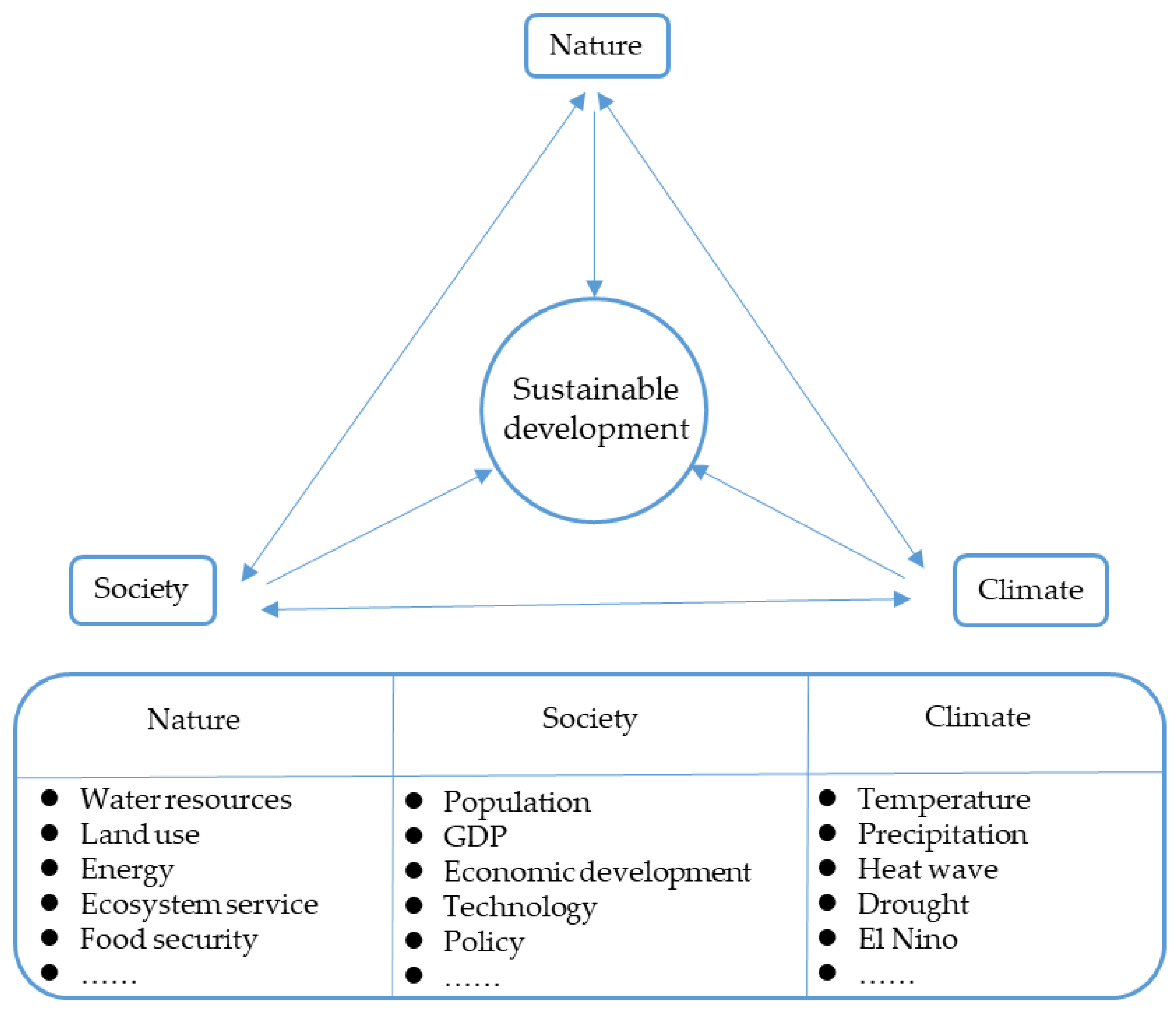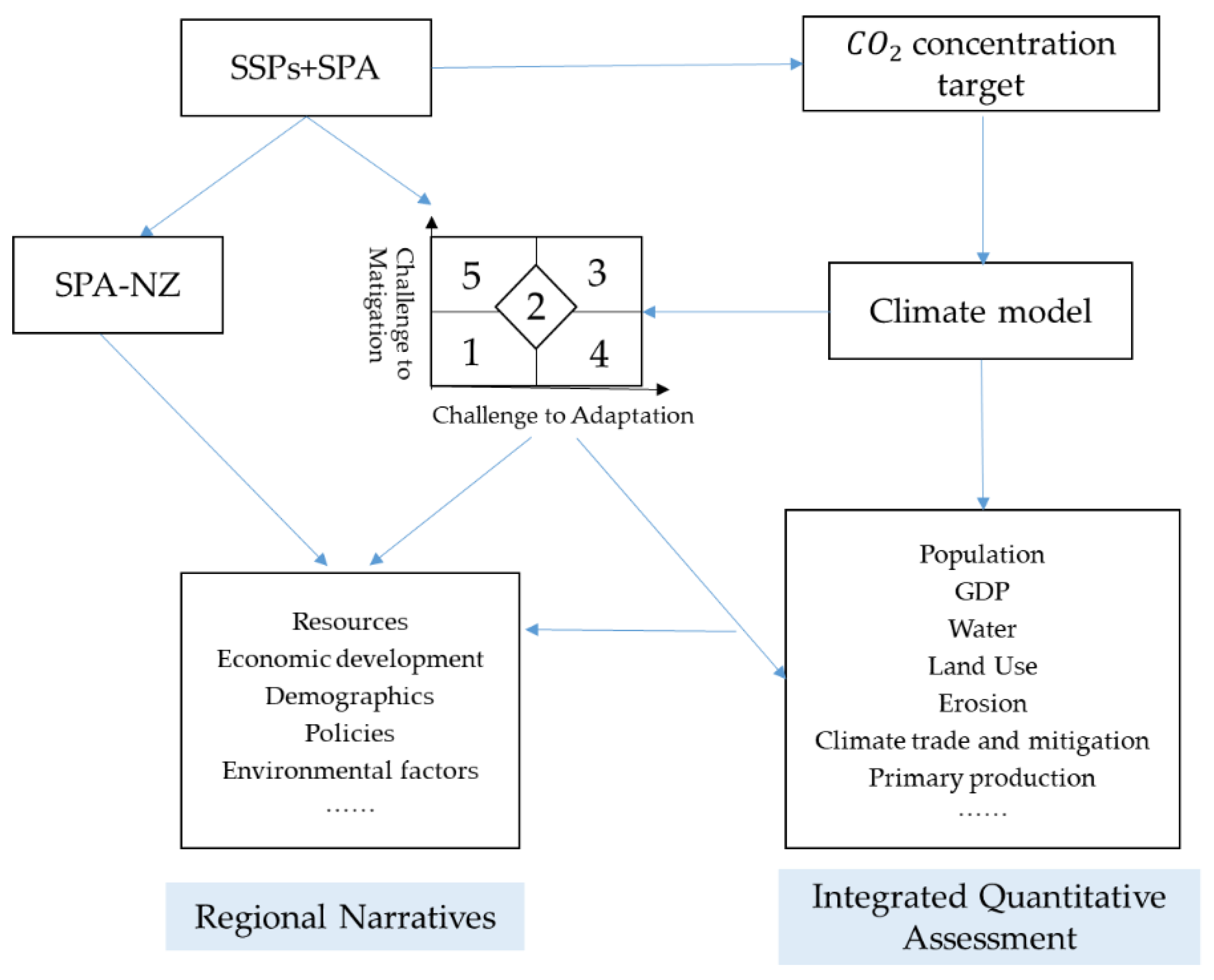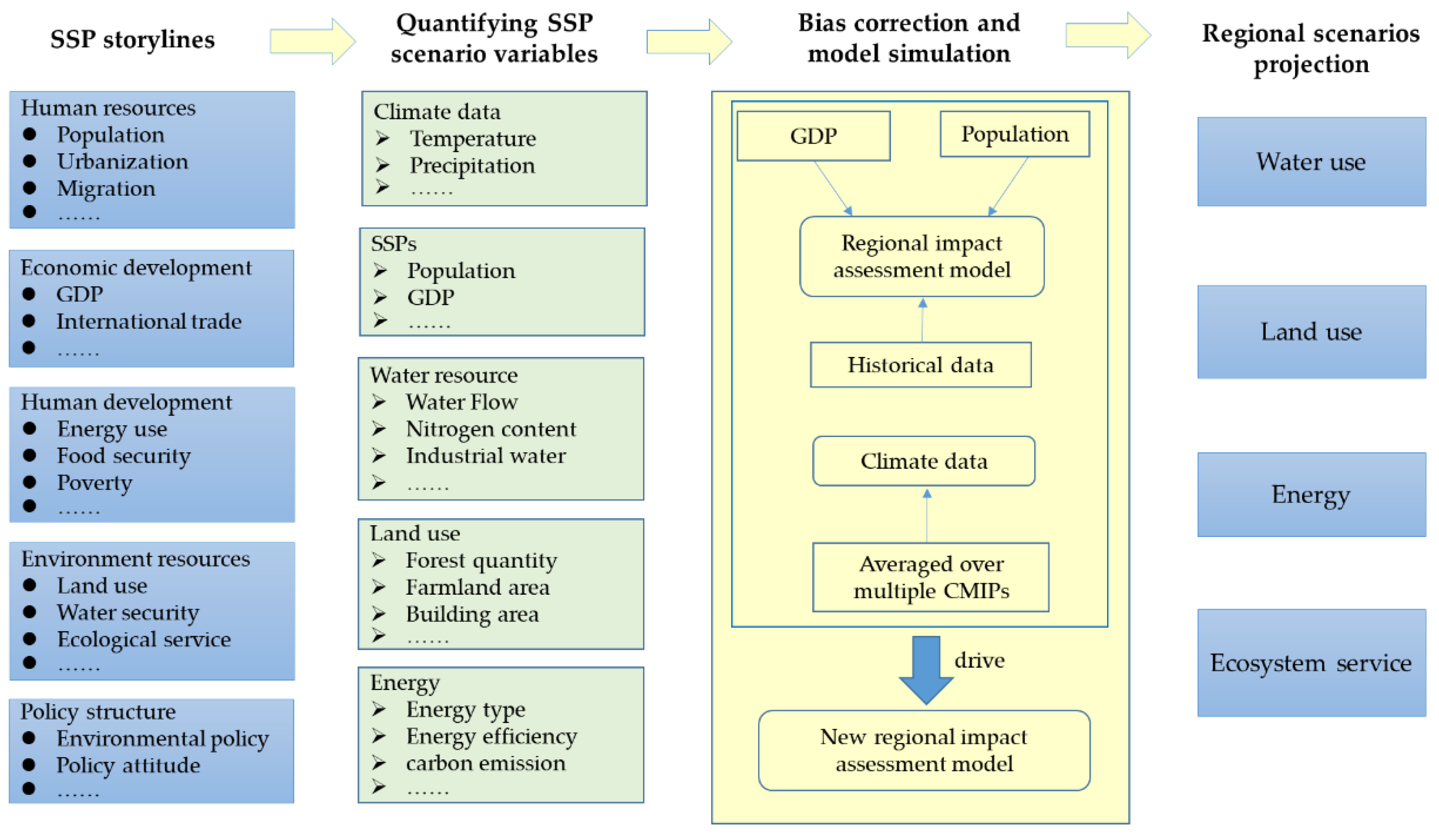Building Regional Sustainable Development Scenarios with the SSP Framework
Abstract
:1. Introduction
2. Exploration of Regional Scenario Projection Methods
2.1. Based on IAM Scenario Analysis
2.1.1. Methods Outline
2.1.2. Method Description
2.2. SSPs-RCPs-SPAs Framework Analysis
2.2.1. Methods Outline
2.2.2. Method Description
2.3. Downscaling Global Impact Assessment Model
2.3.1. Methods Outline
2.3.2. Methods Description
2.4. Regional Impact Assessment Model Simulation
2.4.1. Methods Outline
2.4.2. Methods Description
3. Discussion
3.1. Regional Sustainable Development Scenarios with the SSPs Framework
3.2. Water–Energy–Food Nexus in Regional Sustainable Development
4. Conclusions
Author Contributions
Funding
Acknowledgments
Conflicts of Interest
References
- Disley, Y.P. Sustainable development goals for people and planet. Nature 2013, 495, 21. [Google Scholar]
- Khan, K.A.; Zaman, K.; Shoukry, A.M.; Sharkawy, A.; Gani, S.; Ahmad, J.; Khan, A.; Hishan, S.S. Natural disasters and economic losses: Controlling external migration, energy and environmental resources, water demand, and financial development for global prosperity. Environ. Sci. Pollut. Res. 2019, 26, 14287–14299. [Google Scholar] [CrossRef] [PubMed]
- Giupponi, C.; Gain, A.; Farinosi, F. Spatial Assessment of Water Use Efficiency (SDG Indicator 6.4. 1) for Regional Policy Support. Front. Environ. Sci 2018, 6, 141. [Google Scholar] [CrossRef]
- Schleussner, C.-F.; Rogelj, J.; Schaeffer, M.; Lissner, T.; Licker, R.; Fischer, E.M.; Knutti, R.; Levermann, A.; Frieler, K.; Hare, W. Science and policy characteristics of the Paris Agreement temperature goal. Nat. Clim. Chang. 2016, 6, 827. [Google Scholar] [CrossRef]
- Dumenu, W.K.; Obeng, E.A. Climate change and rural communities in Ghana: Social vulnerability, impacts, adaptations and policy implications. Environ. Sci. Policy 2016, 55, 208–217. [Google Scholar] [CrossRef]
- Rogelj, J.; Luderer, G.; Pietzcker, R.C.; Kriegler, E.; Schaeffer, M.; Krey, V.; Riahi, K. Energy system transformations for limiting end-of-century warming to below 1.5 C. Nat. Clim. Chang. 2015, 5, 519. [Google Scholar] [CrossRef]
- O’Neill, B.C.; Kriegler, E.; Ebi, K.L.; Kemp-Benedict, E.; Riahi, K.; Rothman, D.S.; van Ruijven, B.J.; van Vuuren, D.P.; Birkmann, J.; Kok, K. The roads ahead: Narratives for shared socioeconomic pathways describing world futures in the 21st century. Glob. Environ. Chang. 2017, 42, 169–180. [Google Scholar] [CrossRef] [Green Version]
- Singh, V.; Goyal, M.K. Analysis and trends of precipitation lapse rate and extreme indices over north Sikkim eastern Himalayas under CMIP5ESM-2M RCPs experiments. Atmos. Res. 2016, 167, 34–60. [Google Scholar] [CrossRef]
- Van Vuuren, D.P.; Carter, T.R. Climate and socio-economic scenarios for climate change research and assessment: Reconciling the new with the old. Clim. Chang. 2014, 122, 415–429. [Google Scholar] [CrossRef]
- O’Neill, B.C.; Kriegler, E.; Riahi, K.; Ebi, K.L.; Hallegatte, S.; Carter, T.R.; Mathur, R.; van Vuuren, D.P. A new scenario framework for climate change research: The concept of shared socioeconomic pathways. Clim. Chang. 2014, 122, 387–400. [Google Scholar] [CrossRef]
- Kurniawan, R.; Managi, S. Measuring long-term sustainability with shared socioeconomic pathways using an inclusive wealth framework. Sustain. Dev. 2018, 26, 596–605. [Google Scholar] [CrossRef]
- Robert, K.; Parris, T.; Leiserowitz, A. What is Sustainable Development? Goals, Indicators, Values, and Practice. Environ. Sci. Policy Sustain. Dev. 2005, 47, 8–21. [Google Scholar] [CrossRef]
- Costanza, R.; Daly, L.; Fioramonti, L.; Giovannini, E.; Kubiszewski, I.; Mortensen, L.F.; Pickett, K.E.; Ragnarsdottir, K.V.; Vogli, R.D.; Wilkinson, R. Modelling and measuring sustainable wellbeing in connection with the UN Sustainable Development Goals. Ecol. Econ. 2016, 130, 350–355. [Google Scholar] [CrossRef]
- Jiang, L. Internal consistency of demographic assumptions in the shared socioeconomic pathways. Popul. Environ. 2014, 35, 261–285. [Google Scholar] [CrossRef] [Green Version]
- Riahi, K.; Van Vuuren, D.P.; Kriegler, E.; Edmonds, J.; O’neill, B.C.; Fujimori, S.; Bauer, N.; Calvin, K.; Dellink, R.; Fricko, O. The shared socioeconomic pathways and their energy, land use, and greenhouse gas emissions implications: An overview. Glob. Environ. Chang. 2017, 42, 153–168. [Google Scholar] [CrossRef]
- Rohat, G. Projecting drivers of human vulnerability under the Shared Socioeconomic Pathways. Int. J. Environ. Res. Public Health 2018, 15, 554. [Google Scholar] [CrossRef]
- Hanasaki, N.; Fujimori, S.; Yamamoto, T.; Yoshikawa, S.; Masaki, Y.; Hijioka, Y.; Kainuma, M.; Kanamori, Y.; Masui, T.; Takahashi, K.; et al. A global water scarcity assessment under Shared Socio-economic Pathways—Part 2: Water availability and scarcity. Hydrol. Earth Syst. Sci. Discuss. 2012, 9, 13933–13994. [Google Scholar] [CrossRef]
- Arnell, N.W.; Lloyd-Hughes, B. The global-scale impacts of climate change on water resources and flooding under new climate and socio-economic scenarios. Clim. Chang. 2014, 122, 127–140. [Google Scholar] [CrossRef]
- Schewe, J.; Heinke, J.; Gerten, D.; Haddeland, I.; Arnell, N.W.; Clark, D.B.; Dankers, R.; Eisner, S.; Fekete, B.M.; Colón-González, F.J. Multimodel assessment of water scarcity under climate change. Proc. Natl. Acad. Sci. USA 2014, 111, 3245–3250. [Google Scholar] [CrossRef]
- Jiang, L.; O’Neill, B.C. Global urbanization projections for the Shared Socioeconomic Pathways. Glob. Environ. Chang. 2017, 42, 193–199. [Google Scholar] [CrossRef] [Green Version]
- Chen, W.; Wang, H.; Huang, W.; Li, N.; Shi, J. Shared social-economic pathways (SSPs) modeling: Application of global multi-region energy system model. Energy Procedia 2017, 142, 2467–2472. [Google Scholar] [CrossRef]
- Van Puijenbroek, P.J.T.M.; Beusen, A.H.W.; Bouwman, A.F. Global nitrogen and phosphorus in urban waste water based on the Shared Socio-economic pathways. J. Environ. Manag. 2019, 231, 446–456. [Google Scholar] [CrossRef] [PubMed]
- Absar, S.M.; Preston, B.L. Extending the Shared Socioeconomic Pathways for sub-national impacts, adaptation, and vulnerability studies. Glob. Environ. Chang. 2015, 33, 83–96. [Google Scholar] [CrossRef] [Green Version]
- Zhang, D.; Huang, Q.; He, C.; Wu, J. Impacts of urban expansion on ecosystem services in the Beijing-Tianjin-Hebei urban agglomeration, China: A scenario analysis based on the Shared Socioeconomic Pathways. Resour. Conserv. Recycl. 2017, 125, 115–130. [Google Scholar] [CrossRef]
- Yao, M.; Tramberend, S.; Kabat, P.; Hutjes, R.W.; Werners, S.E. Building regional water-use scenarios consistent with global shared socioeconomic pathways. Environ. Process. 2017, 4, 15–31. [Google Scholar] [CrossRef]
- Doelman, J.C.; Stehfest, E.; Tabeau, A.; van Meijl, H.; Lassaletta, L.; Gernaat, D.E.; Hermans, K.; Harmsen, M.; Daioglou, V.; Biemans, H. Exploring SSP land-use dynamics using the IMAGE model: Regional and gridded scenarios of land-use change and land-based climate change mitigation. Glob. Environ. Chang. 2018, 48, 119–135. [Google Scholar] [CrossRef] [Green Version]
- Nilsson, A.E.; Bay-Larsen, I.; Carlsen, H.; van Oort, B.; Bjørkan, M.; Jylhä, K.; Klyuchnikova, E.; Masloboev, V.; van der Watt, L.-M. Towards extended shared socioeconomic pathways: A combined participatory bottom-up and top-down methodology with results from the Barents region. Glob. Environ. Chang. 2017, 45, 124–132. [Google Scholar] [CrossRef]
- Kebede, A.S.; Nicholls, R.J.; Allan, A.; Arto, I.; Cazcarro, I.; Fernandes, J.A.; Hill, C.T.; Hutton, C.W.; Kay, S.; Lázár, A.N. Applying the global RCP–SSP–SPA scenario framework at sub-national scale: A multi-scale and participatory scenario approach. Sci. Total Environ. 2018, 635, 659–672. [Google Scholar] [CrossRef]
- Dermody, B.J.; Sivapalan, M.; Stehfest, E.; Van Vuuren, D.P.; Wassen, M.J.; Bierkens, M.F.; Dekker, S.C. A framework for modelling the complexities of food and water security under globalisation. Earth Syst. Dyn. 2018, 9, 103–118. [Google Scholar] [CrossRef] [Green Version]
- Mouratiadou, I.; Biewald, A.; Pehl, M.; Bonsch, M.; Baumstark, L.; Klein, D.; Popp, A.; Luderer, G.; Kriegler, E. The impact of climate change mitigation on water demand for energy and food: An integrated analysis based on the Shared Socioeconomic Pathways. Environ. Sci. Policy 2016, 64, 48–58. [Google Scholar] [CrossRef] [Green Version]
- Schaeffer, M.; Gohar, L.; Kriegler, E.; Lowe, J.; Riahi, K.; van Vuuren, D. Mid-and long-term climate projections for fragmented and delayed-action scenarios. Technol. Forecast. Soc. Chang. 2015, 90, 257–268. [Google Scholar] [CrossRef]
- Fujimori, S.; Hanasaki, N.; Masui, T. Projections of industrial water withdrawal under shared socioeconomic pathways and climate mitigation scenarios. Sustain. Sci. 2017, 12, 275–292. [Google Scholar] [CrossRef] [PubMed]
- Popp, A.; Calvin, K.; Fujimori, S.; Havlik, P.; Humpenöder, F.; Stehfest, E.; Bodirsky, B.L.; Dietrich, J.P.; Doelmann, J.C.; Gusti, M. Land-use futures in the shared socio-economic pathways. Glob. Environ. Chang. 2017, 42, 331–345. [Google Scholar] [CrossRef] [Green Version]
- Kriegler, E.; Bauer, N.; Popp, A.; Humpenöder, F.; Leimbach, M.; Strefler, J.; Baumstark, L.; Bodirsky, B.L.; Hilaire, J.; Klein, D. Fossil-fueled development (SSP5): An energy and resource intensive scenario for the 21st century. Glob. Environ. Chang. 2017, 42, 297–315. [Google Scholar] [CrossRef] [Green Version]
- Rao, S.; Klimont, Z.; Smith, S.J.; Van Dingenen, R.; Dentener, F.; Bouwman, L.; Riahi, K.; Amann, M.; Bodirsky, B.L.; van Vuuren, D.P. Future air pollution in the Shared Socio-economic Pathways. Glob. Environ. Chang. 2017, 42, 346–358. [Google Scholar] [CrossRef]
- Bauer, N.; Calvin, K.; Emmerling, J.; Fricko, O.; Fujimori, S.; Hilaire, J.; Eom, J.; Krey, V.; Kriegler, E.; Mouratiadou, I. Shared socio-economic pathways of the energy sector–quantifying the narratives. Glob. Environ. Chang. 2017, 42, 316–330. [Google Scholar] [CrossRef]
- Kriegler, E.; Edmonds, J.; Hallegatte, S.; Ebi, K.L.; Kram, T.; Riahi, K.; Winkler, H.; Van Vuuren, D.P. A new scenario framework for climate change research: The concept of shared climate policy assumptions. Clim. Chang. 2014, 122, 401–414. [Google Scholar] [CrossRef]
- Kriegler, E.; O’Neill, B.C.; Hallegatte, S.; Kram, T.; Lempert, R.J.; Moss, R.H.; Wilbanks, T. The need for and use of socio-economic scenarios for climate change analysis: A new approach based on shared socio-economic pathways. Glob. Environ. Chang. 2012, 22, 807–822. [Google Scholar] [CrossRef]
- Frame, B.; Lawrence, J.; Ausseil, A.-G.; Reisinger, A.; Daigneault, A. Adapting global shared socio-economic pathways for national and local scenarios. Clim. Risk Manag. 2018, 21, 39–51. [Google Scholar] [CrossRef]
- Palazzo, A.; Vervoort, J.M.; Mason-D’Croz, D.; Rutting, L.; Havlík, P.; Islam, S.; Bayala, J.; Valin, H.; Kadi, H.A.K.; Thornton, P. Linking regional stakeholder scenarios and shared socioeconomic pathways: Quantified west African food and climate futures in a global context. Glob. Environ. Chang. 2017, 45, 227–242. [Google Scholar] [CrossRef]
- Wada, Y.; Flörke, M.; Hanasaki, N.; Eisner, S.; Fischer, G.; Tramberend, S.; Satoh, Y.; Van Vliet, M.; Yillia, P.; Ringler, C. Modeling global water use for the 21st century: Water Futures and Solutions (WFaS) initiative and its approaches. Geosci. Model Dev. 2016, 9, 175–222. [Google Scholar] [CrossRef]
- Hanasaki, N.; Fujimori, S.; Yamamoto, T.; Yoshikawa, S.; Masaki, Y.; Hijioka, Y.; Kainuma, M.; Kanamori, Y.; Masui, T.; Takahashi, K.; et al. A global water scarcity assessment under shared socio-economic pathways—Part 1: Water Use. Hydrol. Earth Syst. Sci. 2013, 17, 2375–2391. [Google Scholar] [CrossRef]
- Dong, N.; You, L.; Cai, W.; Li, G.; Lin, H. Land use projections in China under global socioeconomic and emission scenarios: Utilizing a scenario-based land-use change assessment framework. Glob. Environ. Chang. 2018, 50, 164–177. [Google Scholar] [CrossRef]
- Chen, Y.; Li, X.; Liu, X.; Zhang, Y.; Huang, M. Tele-connecting China’s future urban growth to impacts on ecosystem services under the shared socioeconomic pathways. Sci. Total Environ. 2019, 652, 765–779. [Google Scholar] [CrossRef] [PubMed]
- You-Qi, C.; Peng, Y. Recent progresses of international study on land use and land cover change (LUCC). Econ. Geogr. 2001, 21, 96–100. [Google Scholar]
- Komurcu, M.; Emanuel, K.; Huber, M.; Acosta, R. High-Resolution Climate Projections for the Northeastern United States Using Dynamical Downscaling at Convection-Permitting Scales. Earth Space Sci. 2018, 5, 801–826. [Google Scholar] [CrossRef]
- Leimbach, M.; Kriegler, E.; Roming, N.; Schwanitz, J. Future growth patterns of world regions–A GDP scenario approach. Glob. Environ. Chang. 2017, 42, 215–225. [Google Scholar] [CrossRef]
- Kompas, T.; Pham, V.H.; Che, T.N. The effects of climate change on GDP by country and the global economic gains from complying with the Paris Climate Accord. Earth’s Future 2018, 6, 1153–1173. [Google Scholar] [CrossRef]
- Jin, L.; Whitehead, P.G.; Rodda, H.; Macadam, I.; Sarkar, S. Simulating climate change and socio-economic change impacts on flows and water quality in the Mahanadi River system, India. Sci. Total Environ. 2018, 637, 907–917. [Google Scholar] [CrossRef]
- Wang, M.; Kroeze, C.; Strokal, M.; Ma, L. Reactive nitrogen losses from China’s food system for the shared socioeconomic pathways (SSPs). Sci. Total Environ. 2017, 605, 884–893. [Google Scholar] [CrossRef]
- Hu, X.; Iordan, C.M.; Cherubini, F. Estimating future wood outtakes in the Norwegian forestry sector under the shared socioeconomic pathways. Glob. Environ. Chang. 2018, 50, 15–24. [Google Scholar] [CrossRef]
- Wang, C.; Li, B.-B.; Liang, Q.-M.; Wang, J.-C. Has China’s coal consumption already peaked? A demand-side analysis based on hybrid prediction models. Energy 2018, 162, 272–281. [Google Scholar] [CrossRef]
- Levesque, A.; Pietzcker, R.C.; Baumstark, L.; De Stercke, S.; Grübler, A.; Luderer, G. How much energy will buildings consume in 2100? A global perspective within a scenario framework. Energy 2018, 148, 514–527. [Google Scholar] [CrossRef] [Green Version]
- He, C.; Li, J.; Zhang, X.; Liu, Z.; Zhang, D. Will rapid urban expansion in the drylands of northern China continue: A scenario analysis based on the Land Use Scenario Dynamics-urban model and the Shared Socioeconomic Pathways. J. Clean. Prod. 2017, 165, 57–69. [Google Scholar] [CrossRef]
- Bouwer, L.M. Have disaster losses increased due to anthropogenic climate change? Bull. Am. Meteorol. Soc. 2011, 92, 39–46. [Google Scholar] [CrossRef]
- Keesstra, S.; Nunes, J.; Novara, A.; Finger, D.; Avelar, D.; Kalantari, Z.; Cerdà, A. The superior effect of nature based solutions in land management for enhancing ecosystem services. Sci. Total Environ. 2018, 610, 997–1009. [Google Scholar] [CrossRef]
- Biggs, E.M.; Bruce, E.; Boruff, B.; Duncan, J.M.; Horsley, J.; Pauli, N.; McNeill, K.; Neef, A.; Van Ogtrop, F.; Curnow, J. Sustainable development and the water–energy–food nexus: A perspective on livelihoods. Environ. Sci. Policy 2015, 54, 389–397. [Google Scholar] [CrossRef]
- Rasul, G. Food, water, and energy security in South Asia: A nexus perspective from the Hindu Kush Himalayan region☆. Environ. Sci. Policy 2014, 39, 35–48. [Google Scholar] [CrossRef]





| Name | Pathway Narratives |
|---|---|
| SSP1 | SSP1 is a green sustainable development and low-challenge pathway. This pathway has low-resource intensity, less dependence on fossil energy, and high technological progress. Preventing environmental degradation is a priority. Internalizing economies within countries, especially low-income countries, has developed rapidly and reduced poverty. |
| SSP2 | SSP2 is an intermediate pathway, with intermediate challenges from climate change. The main features include the following: The countries have continuously reduced energy-use intensity and made progress towards sustainable development goals, according to the typical development trends in recent decades. |
| SSP3 | SSP3 is a challenging pathway, with substantial climate change challenges related to adaptation and mitigation. The main features include the following: the world is divided into extremely poor areas, middle-income areas and wealthy areas. There is a lack of coordination among these areas, and regional differences are obvious |
| SSP4 | SSP4 is a divided and unbalanced pathway where countries mostly need to adapt to challenges. There is a state of highly uneven development among countries. Adapting challenges are the most important tasks for these countries. |
| SSP5 | SSP5 is a traditional development pathway that focuses on challenges for mitigation. Countries address their own interests and economic development by implementing traditional economic development. |
| Field | Regional Impact Assessment Model | Input | Result | Explanation |
|---|---|---|---|---|
| Water | Integrated Catchment Model (INCA) [49] | historical flows, nitrogen and phosphorus concentration, population, GDP. | flow scenarios CNRM-CM5, HadGEM2, GFDL, nitrogen and phosphorus concentration scenarios of GFDL. | The growth of population and economy increases water use and sewage drainage, which increases the nitrogen and phosphorus concentrations in rivers. Extreme weather results in unstable flows. |
| Industrial Water Withdrawal (IWW) [32] | population, GDP, industrial water use, energy efficiency in water production, carbon emissions. | Industrial water consumption regression model, IWW export from CGE, carbon capture and storage, carbon tax. | There are differences in industrial water-use scenarios with and without climate mitigation policies. The use of renewable energy reduces heat use, and a high carbon tax can reduce greenhouse gas emissions. | |
| Land use | Land-Use Scenario Dynamics-Urban (LUSD-Urban) Model [24] | historical population data, land spatial distribution, urbanization rate, urban functional partition, temperature, precipitation, population, GDP. | population and urban spatial distribution regression model, urban spatial distribution with SSPs, food production, carbon storage, water retention and air purification scenarios. | The expansion of urban agglomerations occupies farmland and forest land. Building land is expanding. However, green plants and biomass are weakened, reducing ecosystem capacity, and service functions are correspondingly weakened [44]. |
| NUFER (Nutrient Flows and Food Chain, Environment and Resources Use) Model [50] | food consumption, production and distribution, poultry production, and grain production. | nitrogen use efficiency, methane, nitrogen oxide emissions, nitrogen concentration projection scenarios in SSPs, N losses. | The reduction in nitrogen loss results from increasing food production and consumption, such as increasing agricultural production efficiency and recycling of food production and the consumption chain. | |
| Forest Resource Projection [51], Tree Yield Regression Model | population, GDP, historical data on tree species and wood grades, temperature, precipitation, land-use spatial distribution. | tree survival rate in SSPs and quantity of types of trees. | Population growth, land use, human participation, and climate change mitigation policies will influence tree survival and numbers in the future. | |
| Energy | REMIND/MAgPie [30] | Population, GDP, energy structure, energy use efficiency, industrial structure. [52] | greenhouse gas emissions scenarios, the demand of coal, oil, natural gas, and electrical energy in the future. | The use of high-carbon energy resources and social technologies [53] affects emissions, and the emissions play an important role in meeting the temperature goal. |
© 2019 by the authors. Licensee MDPI, Basel, Switzerland. This article is an open access article distributed under the terms and conditions of the Creative Commons Attribution (CC BY) license (http://creativecommons.org/licenses/by/4.0/).
Share and Cite
Yang, S.; Cui, X. Building Regional Sustainable Development Scenarios with the SSP Framework. Sustainability 2019, 11, 5712. https://doi.org/10.3390/su11205712
Yang S, Cui X. Building Regional Sustainable Development Scenarios with the SSP Framework. Sustainability. 2019; 11(20):5712. https://doi.org/10.3390/su11205712
Chicago/Turabian StyleYang, Shuhui, and Xuefeng Cui. 2019. "Building Regional Sustainable Development Scenarios with the SSP Framework" Sustainability 11, no. 20: 5712. https://doi.org/10.3390/su11205712
APA StyleYang, S., & Cui, X. (2019). Building Regional Sustainable Development Scenarios with the SSP Framework. Sustainability, 11(20), 5712. https://doi.org/10.3390/su11205712




